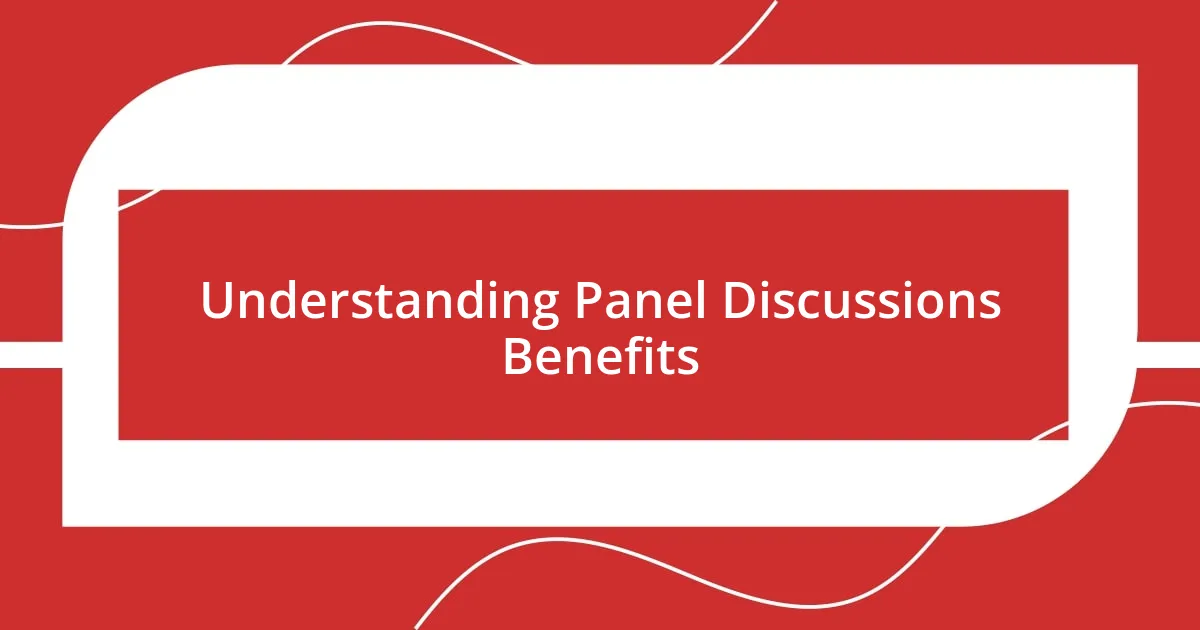Key takeaways:
- Panel discussions offer diverse perspectives, fostering innovative ideas and critical thinking among participants.
- Effective preparation involves knowing panelists, setting clear objectives, and creating a comfortable environment for open dialogue.
- Engagement techniques like icebreakers and encouraging panelist interaction enhance the discussion’s dynamism and audience connection.
- Evaluating outcomes through audience feedback and summarization helps assess the discussion’s impact and effectiveness.

Understanding Panel Discussions Benefits
One of the standout benefits of panel discussions is the diverse range of perspectives they bring to the table. I once attended a panel featuring experts from completely different fields, and the way they built on each other’s ideas was eye-opening. It made me realize how often we stick to our own circles, missing opportunities for richer conversations and innovation.
Moreover, panel discussions can ignite passion and foster community among participants. I remember a particularly lively session where the audience felt empowered to ask questions and share thoughts. It struck me how those interactions can turn a simple discussion into a collaborative experience, prompting fresh ideas and fueling motivation. Isn’t it exhilarating to be part of something where everyone is eager to contribute?
Finally, the format of panel discussions encourages critical thinking. As I sat listening to different viewpoints clash and harmonize, I found myself challenged to think beyond my own beliefs. This dynamic made me appreciate the necessity of evaluating different angles before forming strong opinions. Isn’t that the essence of personal growth—being opened to new ways of seeing the world?

Preparing for a Successful Panel
Preparing for a successful panel requires thoughtful planning and a clear strategy. I remember attending a panel where the moderator didn’t adequately prepare, leading to awkward silences and disjointed discussions. It made me realize how important it is to outline the key topics and questions in advance to keep the conversation flowing and engaging.
Here are some essential steps to consider when preparing for your panel:
– Know Your Panelists: Research their backgrounds and areas of expertise to tailor questions that spark meaningful dialogue.
– Set Clear Objectives: Determine what you want the audience to take away from the discussion.
– Create a Comfortable Environment: Ensure all panelists feel welcomed and valued, as a relaxed atmosphere encourages open conversations.
– Rehearse Moderation Techniques: Prepare to gracefully redirect the discussion if it veers off-topic or if one panelist dominates the conversation.

Tips for Engaging Panelists
Engaging panelists requires a delicate balance of preparation and interpersonal skills. I’ve found that starting with icebreakers can significantly ease the tension. For instance, at a recent event, I used a light-hearted question related to the panelists’ experiences in their fields, and the laughter that followed set a positive tone for the entire discussion. It’s surprising how a simple, relatable question can transform the atmosphere and encourage panelists to share more than just their rehearsed lines.
Another vital tip is to encourage interaction among panelists. I’ve noticed that when panelists feel comfortable interacting with one another, the conversation becomes more dynamic and enjoyable. During one panel I moderated, instead of merely directing questions to individual panelists, I prompted them to respond to each other’s points. The sparks that flew from those interactions were truly delightful, creating a richer dialogue that resonated with both the audience and the speakers.
Finally, don’t underestimate the power of active listening. When I’ve been in the audience, it really stood out to me when a moderator genuinely engaged with the responses of panelists. By building on their points and asking follow-up questions, the moderator highlighted the importance of what was being said. This not only validates the speakers but also keeps the energy flowing and encourages deeper explorations of the topics at hand.
| Tip | Description |
|---|---|
| Icebreakers | Start with light questions to ease tension and create a positive atmosphere. |
| Encourage Interaction | Promote dialogue between panelists for a more dynamic discussion. |
| Active Listening | Engage with panelists’ responses to deepen the conversation. |

Crafting Effective Questions
Crafting effective questions is a skill I’ve come to appreciate deeply over the years. I’ve learned that open-ended questions are particularly powerful; they invite panelists to share their insights and interpretations rather than just yes or no responses. For instance, instead of asking a panelist if they agree with a trend in their industry, I might ask, “What do you believe has driven this trend, and how do you see it shaping our future?” This simple shift can lead to richer discussions and insights.
In my experience, specificity is key when formulating questions. Vague questions often lead to vague answers, which can leave the audience wanting more. I recall a panel where I aimed for depth by asking a specific question about a panelist’s project that tied into the broader themes of the discussion. Not only did they share valuable details, but their enthusiasm was contagious, igniting a lively discussion that engaged everyone in the room.
Sometimes, I think about the dynamics in a panel: How can I keep things fresh and stimulating? I often incorporate questions that create a bit of friendly debate among panelists. For instance, asking, “What would you do differently if you were in charge of XYZ?” encourages them to take a stand and sparks fruitful dialogue. After trying this technique, I found that the energy in the room shifts, fostering a lively exchange that feels spontaneous and vibrant, making for an unforgettable experience.

Managing Audience Participation
Managing audience participation during a panel discussion is crucial for creating an engaging experience. I’ve realized the importance of setting clear guidelines at the start. By explaining how and when the audience can participate, I’ve noticed that it reduces confusion and encourages more thoughtful interaction. It’s incredible to see how a little structure can empower audience members to share their thoughts without hesitation.
One memorable experience I had involved using a feedback system for questions. Instead of relying solely on hands raised, I handed out cards for audience members to jot down their inquiries anonymously. This approach not only made those who were shy feel more comfortable speaking up, but also produced some of the most insightful questions. Who knew that a simple card could bridge the gap between the audience and panelists?
Moreover, I’ve found that recognizing audience contributions is essential in managing participation effectively. There was an event where a participant shared a personal story that tied beautifully to the discussion. By acknowledging it and inviting the panelists to respond, I witnessed a spark of connection among everyone in the room. It reminded me that audience participation isn’t just about asking questions; it’s about creating a shared experience that resonates with both the speakers and attendees. How do you create those moments of connection in your discussions? It’s all about being present and responsive.

Evaluating Panel Discussion Outcomes
Evaluating panel discussion outcomes can often feel like a reflective exercise to me. I’ve found that analyzing audience feedback is invaluable; it reveals not only the effectiveness of the discussion but also the insights that resonated most with attendees. For instance, after one panel, I reviewed post-event surveys and discovered that a specific point made by a panelist sparked meaningful conversations among participants long after the event. This made me realize how important it is to gauge whether the discussion achieved its intended impact.
I also think about how to measure the engagement level during the event itself. I once attended a panel where the moderator frequently checked in with the audience through live polls. This not only kept everyone on their toes but also provided immediate feedback on what themes were firing up interest. I felt more connected and involved, and it drove home the idea that evaluating outcomes isn’t just an afterthought; it can be integrated into the discussion as it unfolds.
One thing I’ve learned is that reviewing the overall takeaway messages can be quite revealing. During a recent panel, I made a point to summarize the main insights shared before concluding the session. When I later followed up with the panelists, they expressed pride in how their distinct viewpoints blended cohesively. It made me wonder: how often do we overlook the potential of summarizing to crystallize learning? In my experience, it not only helps wrap up the event but also reinforces the lasting impact of the dialogue we just had.

Improving Future Panel Experiences
To enhance future panel experiences, considering the roles of both the panelists and the audience is vital. I’ve found that selecting panelists who genuinely engage with each other can create a vibrant atmosphere. Once, I attended an event where the chemistry between the speakers was palpable; their lively debate ignited the audience’s interest. It made me wonder—how can we ensure that future panels prioritize this dynamic energy?
Another valuable improvement is experimenting with format. I’ve noticed that mixing traditional panels with breakout sessions offers attendees the chance to dive deeper into topics that pique their interest. At one gathering, we shifted to small group discussions after the main event, and participants left buzzing with ideas and connections. Isn’t it intriguing how a little change in structure can elevate the entire experience?
Lastly, I believe in regularly training moderators in the art of conversation. I’ve been part of panels where the moderator seamlessly navigated between the audience and the speakers, enriching the dialogue. That experience left me reflecting on how pivotal great moderation is for a panel’s success. What if every moderator focused on honing these skills? The impact could be transformative, ensuring that every voice is heard and valued.















